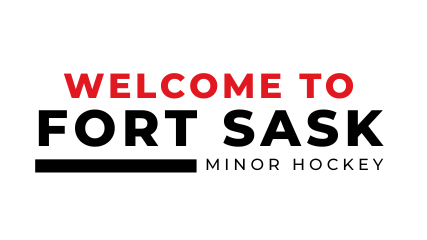
Why do you need Shoulder Pads for Hockey?
Shoulder pads have a few different purposes. They cover key areas on the upper body including your shoulder, collar bone, spine, sternum, ribcage, and bicep. They do this by using a combination of mid- and high-density foams, as well as plastics in some key areas.
Popular brands
The most common brands are:
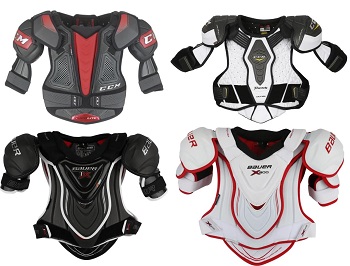 Bauer (Supreme, Vapor, Nexus)
Bauer (Supreme, Vapor, Nexus)- CCM (, JetSpeed, QuickLite, Super Tacks)
- Warrior (Alpha, Dynasty)
- Easton (now owned by Bauer – Stealth, Synergy)
Other companies like Graf, STX, Winnwell, Powertek, Tron, DR, Sher-Wood, etc. also make shoulder pads, but this market is changing rapidly. Easton was recently acquired by Bauer and will likely be discontinued, while Graf is going out of business in North America and may only be found on clearance. Brands like Tron and Powertek are entry-level “budget brands.” Sher-wood is best known for its retro style, minimalist shoulder pads, but makes good modern ones as well.
Shoulder Pad Sizing & Fit
There are several aspects to the fit of a shoulder pad. It should sit so the shoulder caps rest on the curvature of your shoulders, and should also cover your rib cage and collar bone. Don’t worry if it doesn’t cover your entire stomach – this would decrease mobility and be quite uncomfortable to play in. Remember that your hockey pants will come up to the top of your hips, removing much of this gap.
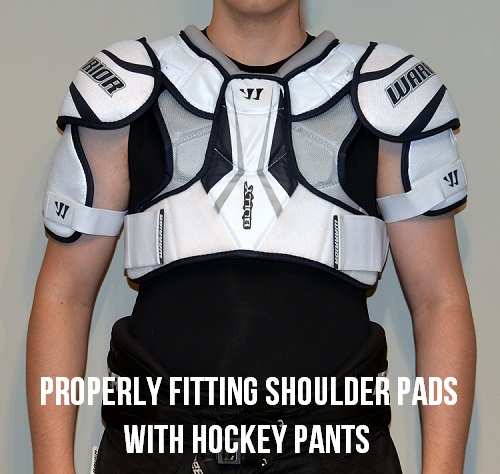
Signs that your shoulder pads are too big:
- Neckline droops, exposing collar bone
- Pulling neckline to one side can expose shoulder through the neck hole
- Shoulder caps look droopy, centered on the deltoid muscle rather than the shoulder
- Bottom edges of pad extend well past the rib cage
Signs that your shoulder pads are too small:
- Neckline interferes with comfort and mobility of the neck
- Top of shoulder caps point directly upwards rather than outwards
- Raising arms above head causes shoulder caps to pinch in towards face
- Bottom edges of pad leave substantial amount of rib cage exposed
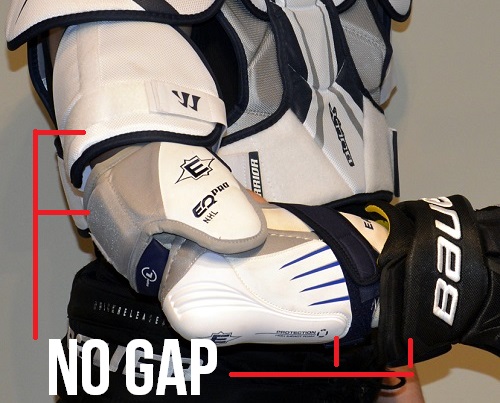
Borrowing the above picture from our elbow pad fitting article you can see the “gapless arm”. With properly fitting equipment the should be little to no gap between the glove, elbow pads, and shoulder pads. If you have an overlap then something may be too big, and if there are large gaps than something may be too small.
There are a few women’s specific shoulder pads on the market. They generally feature shaped, molded plates covering the chest area, and an overall fit designed for women. Some women find these shoulder pads more comfortable, while others find them too restricting in movement, particularly when lunging forward due to the chest plates. In my experience selling hockey equipment, the split is about 50/50 preference between women’s and men’s shoulder pads for women.
Recommendations When Buying Shoulder Pads
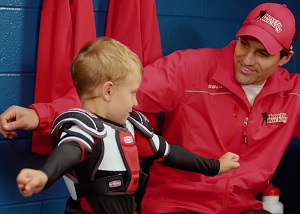 Youth hockey players are required to wear shoulder pads, children grow quickly and will need new shoulder pads every few years. Always check the fit before the beginning of the season.
Youth hockey players are required to wear shoulder pads, children grow quickly and will need new shoulder pads every few years. Always check the fit before the beginning of the season.
For adult hockey players – although still useful – shoulder pads are much less critical than many other pieces of equipment – falling directly on your shoulder is far less common than landing on your elbow or butt. High-end shoulder pads can be great at what they do, but they aren’t necessary for recreational hockey unless your league is very rough, or you like blocking shots with your chest. Players on a tight budget would do well to save money here to free up cash for more vital pieces of equipment such as skates. A regular price of around $60-90 is more than enough for the demands of the average recreational league and many seasoned rec hockey player opt to not wear shoulder pads at all.
Should I buy used Shoulder Pads?
Buying used shoulder pads is a great way to save money. Make sure both bicep guards (and the belly flap, if applicable) are attached, and all straps are intact with good working velcro.
Shoulder Pad Sizing Video
